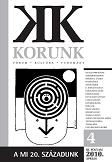Huszadik századi magyar társadalmak
Twentieth-Century Hungarian Societies
Author(s): Gábor GyániSubject(s): History
Published by: Korunk Baráti Társaság
Keywords: Hungary; social development; structural duality; modernisation; individualization
Summary/Abstract: Hungary’s history was closely shaped or even determined throughout the 20th century by a few recurring breaks and renewals caused by the several shifts of the political regime, the drastic territorial and demographic changes, and the transition from an imperial half-dependence to the quasi or real nation-state sovereignty and/or imperial subordination again. Each of the hectic changes did their impact on the societal processes going on in the country. The rhythm and the way Hungarian society headed for modernity was thus always affected negatively by these outer influencing factors. This was to give birth to the idea declaring that the development towards modernity is and has always been hindered by survival of the many remnants of feudalism. The notion was developed further in the form of the theory of a dual structure of Hungary’s society, held to be the main defining structural characteristic before 1945. The plausibility and great popularity of the hypothesis has been shown by the fact that even the late Kádárist socio-economic structure was frequently interpreted by basing on the notion of a structural duality. When the whole problem is seen now from the perspective of the turn of the 20th and 21st century, the individualization process seems to play the most decisive or at least the most persisting role all the time in the social development of Hungary.
Journal: Korunk
- Issue Year: 2010
- Issue No: 04
- Page Range: 18-29
- Page Count: 12
- Language: Hungarian

